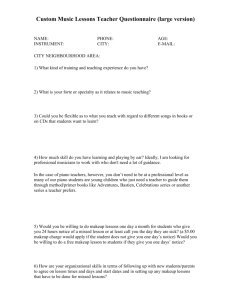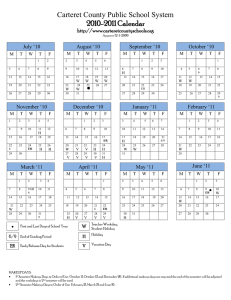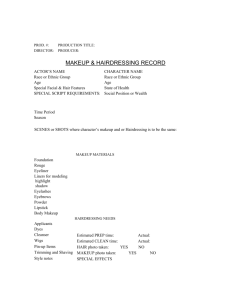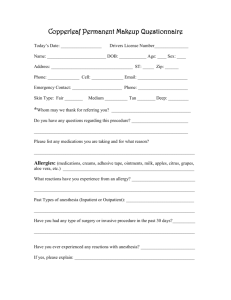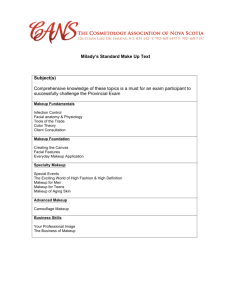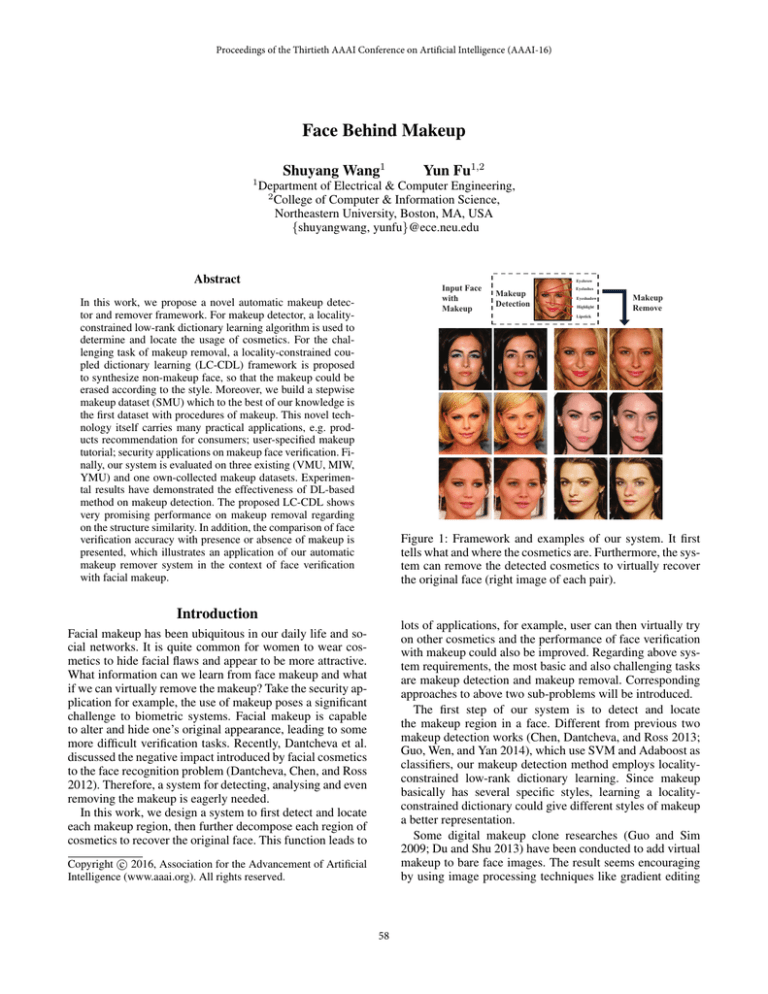
Proceedings of the Thirtieth AAAI Conference on Artificial Intelligence (AAAI-16)
Face Behind Makeup
1
Shuyang Wang1
Yun Fu1,2
Department of Electrical & Computer Engineering,
2
College of Computer & Information Science,
Northeastern University, Boston, MA, USA
{shuyangwang, yunfu}@ece.neu.edu
Abstract
(\HEURZ
,QSXW)DFH
ZLWK
0DNHXS
In this work, we propose a novel automatic makeup detector and remover framework. For makeup detector, a localityconstrained low-rank dictionary learning algorithm is used to
determine and locate the usage of cosmetics. For the challenging task of makeup removal, a locality-constrained coupled dictionary learning (LC-CDL) framework is proposed
to synthesize non-makeup face, so that the makeup could be
erased according to the style. Moreover, we build a stepwise
makeup dataset (SMU) which to the best of our knowledge is
the first dataset with procedures of makeup. This novel technology itself carries many practical applications, e.g. products recommendation for consumers; user-specified makeup
tutorial; security applications on makeup face verification. Finally, our system is evaluated on three existing (VMU, MIW,
YMU) and one own-collected makeup datasets. Experimental results have demonstrated the effectiveness of DL-based
method on makeup detection. The proposed LC-CDL shows
very promising performance on makeup removal regarding
on the structure similarity. In addition, the comparison of face
verification accuracy with presence or absence of makeup is
presented, which illustrates an application of our automatic
makeup remover system in the context of face verification
with facial makeup.
0DNHXS
'HWHFWLRQ
(\HODVKHV
(\HVKDGRZ
+LJKOLJKW
0DNHXS
5HPRYH
/LSVWLFN
Figure 1: Framework and examples of our system. It first
tells what and where the cosmetics are. Furthermore, the system can remove the detected cosmetics to virtually recover
the original face (right image of each pair).
Introduction
lots of applications, for example, user can then virtually try
on other cosmetics and the performance of face verification
with makeup could also be improved. Regarding above system requirements, the most basic and also challenging tasks
are makeup detection and makeup removal. Corresponding
approaches to above two sub-problems will be introduced.
The first step of our system is to detect and locate
the makeup region in a face. Different from previous two
makeup detection works (Chen, Dantcheva, and Ross 2013;
Guo, Wen, and Yan 2014), which use SVM and Adaboost as
classifiers, our makeup detection method employs localityconstrained low-rank dictionary learning. Since makeup
basically has several specific styles, learning a localityconstrained dictionary could give different styles of makeup
a better representation.
Some digital makeup clone researches (Guo and Sim
2009; Du and Shu 2013) have been conducted to add virtual
makeup to bare face images. The result seems encouraging
by using image processing techniques like gradient editing
Facial makeup has been ubiquitous in our daily life and social networks. It is quite common for women to wear cosmetics to hide facial flaws and appear to be more attractive.
What information can we learn from face makeup and what
if we can virtually remove the makeup? Take the security application for example, the use of makeup poses a significant
challenge to biometric systems. Facial makeup is capable
to alter and hide one’s original appearance, leading to some
more difficult verification tasks. Recently, Dantcheva et al.
discussed the negative impact introduced by facial cosmetics
to the face recognition problem (Dantcheva, Chen, and Ross
2012). Therefore, a system for detecting, analysing and even
removing the makeup is eagerly needed.
In this work, we design a system to first detect and locate
each makeup region, then further decompose each region of
cosmetics to recover the original face. This function leads to
c 2016, Association for the Advancement of Artificial
Copyright Intelligence (www.aaai.org). All rights reserved.
58
both makeup and non-makeup face then do the face matching based on correlation mapping. Above makeup face related works focus on the makeup’s affection with face recognition and involve in a pre-processing of makeup detection,
whereas our system further performing the makeup remove.
Since makeup remove is essentially a novel cross-modal
synthesis problem, which shares some basic assumptions
with image super-resolution (Walha et al. 2014) or sketchphoto synthesis (Zhang et al. 2015) problem and dictionary
learning based methods have been proved to be successfully
in dealing with this kind of tasks. Thus, we briefly review
some dictionary learning (DL) works.
Recent researches have contributed to the rapid growth in
the theory and application of DL (Yang, Zhang, and Feng
2011) and low-rank regularization (Liu, Lin, and Yu 2010;
Zhao and Fu 2015). The performance of problems like image classification has been improved dramatically with a
well-adapted discriminative low-rank dictionary (Ma et al.
2012; Li, Li, and Fu 2014). In the cross-modal DL literature, Wang et al. (Wang et al. 2012) proposed semicoupled dictionary learning to conduct sketch-photo synthesis. DL methods for cross-domain problems (Huang and
Wang 2013; Ding, Ming, and Fu 2014) have been proposed
in recent literature, aiming to capture more intrinsic structure and achieve a better representation.
In sparse based methods, the local structure was ignored
with the assumption that each point has independent linear
representation. To specifically encourage the coding to rely
on the spatial consistency of neighbor sample points, Local
Coordinate Coding (LCC) was presented recently (Wang et
al. 2010). Motivated by above algorithms, we explore the
makeup detection problem by adding locality regularization
on low-rank dictionary learning, meanwhile, introduce locality constraint coupled dictionary learning (LC-CDL) to
perform makeup remove. Thus, the makeup style information can be exploited in more thorough manner.
and alpha blending on different color channels. Compared to
adding makeup to naked face problem, however, we focus
on a totally different one, makeup removal. Unlike covering human skin with virtual cosmetics, we design a method
to recover the occluded original face, which is actually an
ill-posed problem. For makeup removal, we consider it as
a multi-step cross-modal problem, that is each makeup status is a modal and non-makeup modal can be synthesized
from makeup modal stepwise. To this end, we propose a
locality-constrained coupled dictionary learning (LC-CDL)
algorithm. Besides, since this is the first work trying to do
the makeup reversion, we collect a new dataset called Stepwise Makeup Dataset (SMU). Compared to other three existing makeup datasets, SMU dataset is the first one contains
multiple steps of makeup images and each image was labeled with makeup status information in sub-region of face.
The main contributions of our work are: 1) we develop a
system to detect facial makeup and reverse it automatically.
To our best knowledge, we are the first to recover original
face from makeup face; 2) we collect a stepwise makeup
(SMU) dataset for the sake of makeup reversion and conduct several experiments on this dataset; 3) a new LC-CDL
algorithm based on SCDL (Wang et al. 2012) is deployed
to remove makeup, and a postprocess with Poisson editing
and ratio-image merging is applied to produce a more realistic synthesis result; and 4) dictionary learning algorithm is
introduced to detect facial makeup.
Related Works
In this section, we briefly discuss related works from both
application and techniques. Facial beauty has recently begun to draw attentions in pattern recognition and computer
vision areas. However the research topics are barely focus
on face beauty estimation (Wang, Shao, and Fu 2014) while
the research related with facial makeup is still quite limited. The research on makeup recommendation system arises
these two years. In (Liu et al. 2013), Liu, et al. developed
a system for hairstyle and facial makeup recommendation
and synthesis. They applied candidate makeup into an original face and recommend to users the makeup which result
a highest beauty score. This system produces appealing results but still has a lot of limitation, such as they can only
deal with a non-makeup face.
Compared with works on makeup recommendation, the
research dealing with makeup face is even rare. Dantcheva,
et al. was the first work to explicitly establish the impact
of facial makeup on a face recognition system (Dantcheva,
Chen, and Ross 2012). They assembled two datasets,
YouTube MakeUp database and Virtual MakeUp database,
then tested the recognition performance before and after
makeup with three face recognition features: Gabor wavlets,
Local Binary Pattern and the commercial Verilook Face
Tookit. Based on this work, there are two papers focusing
on makeup face. In (Chen, Dantcheva, and Ross 2013), they
detected the presence of makeup in face images based on
a feature vector which contains shape, texture and color information. The other one (Guo, Wen, and Yan 2014) dealt
with the verification problem. They extracted features from
Makeup Detection
The few existing works related to automatic makeup detection are all based on SVM and Adaboost classifier (Chen,
Dantcheva, and Ross 2013; Guo, Wen, and Yan 2014),
which ignores the intrinsic local information of makeup.
To find a better representation of makeup, we use localityconstrained low-rank dictionary learning algorithm given
following three observations:
1. Most of the data related to makeup are unconstrained wild
images which vary on pose, expression and illumination,
sometimes even have occlusion on makeup region. To this
end, error term is necessary to exorcise the sparse noises.
2. Cosmetics hide facial flaws, meanwhile inevitably cover
some individual facial characteristics, which reduces the
within-class identity variation. Therefore low-rank is introduced to discover a pure and compact dictionary.
3. Inspired by (Wang et al. 2010; Yu, Zhang, and Gong
2009) , under certain assumptions, locality plays more
essential roles than sparsity. That means similar samples
should be represented with similar features.
59
Locality-constrained low-rank dictionary learning
Ŵ = arg minY − W A22 + λW 22 ,
Define matrix X = [X1 , X2 , . . . , Xc ] as the training data
from c different classes (c equals to 2 as makeup and nonmakeup number in this paper), X ∈ Rd×N , with d feature
dimension and N total training samples. For i-th class samples Xi , a sparse representation matrix Ai is yield from a
group of learned sub-dictionaries D = [D1 , D2 , . . . , Dc ] and
used to facilitate future classification task. The training data
then can be represented by Xi = DAi + Ei with Ei as the
sparse noises.
In this task dealing with makeup faces, the within-class
samples usually have same style (e.g. red lips, black eye
shadow) and lie in a low dimensional manifold. Therefore,
the dictionary is expected to be learned with the most concise atoms by minimizing the matrix rank norm. As (Candès
et al. 2011) suggested, the nuclear norm Di ∗ can be used
as a surrogate for the rank of Di , where .∗ denotes the sum
of singular values of the matrix. In addition, as suggested by
LCC (Yu, Zhang, and Gong 2009), locality plays more essential roles than sparsity given the fact that locality must
guarantee sparsity but not necessarily vice versa. Specifically, the locality regularization uses the following criteria:
minlk ak 22 , s.t. 1T ak = 1, ∀k,
a
W
where Y is the class label matrix, and A is the localityconstrained coefficients of X. This yields Ŵ = Y AT (AAT +
λI)−1 . For each incoming testing sample xtest , the predicted
label vector is computed as Ŵ atest , where atest is the coefficient vector learned from proposed model. Specifically, the
position of the largest value in the label vector is used as the
final class label assigned to the testing data.
Makeup Decomposition
To the best of our knowledge, this is the first work to recover
a non-makeup face by automatically removing the cosmetics from a makeup face . The makeup decomposition problem can be formulated as follows: given an makeup image
Xm , how to recover the associated nuke face Xn ? This is
totally different from previous published virtual makeup papers, which add makeup to a nuke face using makeup example. In this problem, the original face is almost covered
up by cosmetics which makes it an ill-conditioned problem.
A well-known fact is that makeup has some standard styles,
which could benefit our makeup decomposition by learning
these styles from training data with local structure. To solve
this challenging problem, we propose a locality-constrained
coupled dictionary learning method called LC-CDL.
(1)
where lk is the locality adaptor for k-th coefficient ak , and
denotes the element-wise multiplication. Specifically,
[dist(xk , d1 ), . . . , dist(xk , dn )]T
).
lk = exp(
σ
Preprocessing
Accurate pixel-wise alignment is necessary for realistic face
synthesis in our task, since we learn pair-wise dictionaries
which require corresponding face region in before and after makeup. To establish a unified training set, all face images with the size of 150 × 130 are automatically aligned
with 83 facial landmarks extracted through Face++1 (Inc.
2013). These fiducial points define an affine warp, which is
then used in Thin Plate Spline (Donato and Belongie 2002)
method to warp the images into a canonical form.
As we can see, the makeup styles are usually complicated
or varied in the dataset and practical application. Some face
may only have lipsticks while some could apply eye shadow
and face foundation. That makes it impossible to recover all
kinds of makeup by training only one pair of dictionaries.
Therefore, different pairs of dictionaries should be assigned
to different face regions. For this reason, we separate whole
face into three region (facial skin, upper/lower mouth lips,
left/right eye) in the preprocessing step.
(2)
where dist(xk , dj ) represents the Euclidian distance between input sample xk and each basis vector dj . Accordingly, locality constraint assigns different freedom to dictionary atoms proportional to their similarity with input data
xk .
Considering the low-rank constraint term on the subdictionaries as well as the locality regularization on the coding coefficients, each sub-dictionary have the following objective function:
min R(Di , Ai ) + αDi ∗ + βEi 1
D
i ,Ai ,Ei
ni
+λ k=1
li,k
ai,k 22 s.t. Xi = DAi + Ei ,
(3)
where α and β are two balanced parameters. Note that
R(Di , Ai ) endows sub-dictionary Di with the discriminability to well represent samples from i-th class by minimizing following:
R(Di , Ai ) = Xi − Di Aii − Ei 2F +
c
Locality-constrained coupled dictionary learning
Consider the situation in the same style makeup procedure,
all subjects should have similar changes from previous status to the next, which suggests that the styles can be converted between each other in a hidden space. We first illustrate the procedure in a simple two-steps situation. Denote
Xm and Xn as the sample sets formed by the image patch
pairs of makeup and non-makeup. Since each pair of images indicates the similar makeup effect, it is reasonable to
Di Aij 2F , (4)
j=1,=i
where
Aji
(5)
is the coefficient matrix of Xi over Dj .
Classification method
A linear classifier Ŵ is obtained using the multivariate ridge
regression model (Zhang, Jiang, and Davis 2013):
1
The Face++ Research Toolkit can be downloaded from
http://www.faceplusplus.com/.
60
dictionary by only keeping the set of basis in Dm whose
corresponding weights are larger than a predefined constant. The corresponding weights are calculated with locality constraint between Xm and Dm . Then both Xm , Dm and
δP An , δI are used to update Am .
Algorithm 1 Updating coefficients Am
Input: Training data Xm , Dictionary Dm , Projection P
coupled coefficient An , Parameters δ, γ
1. for i = 1 to N do
2.
for i = 1 to number of atoms in (Dm ) do
lm,k ←− exp(xm,k − dm,i 2 /σ)
3.
end for
4. end for
5. lm ←− normalize(0,1] (lm )
6. Am ←− arg minXm − Dm Am 2F + γlm am 2
Synthesis with Poisson Editing and Ratio-image
Merging
Since preprocessing step will warp the face into a canonical form and only retain the central part of the face, to make
the result more realistic, it requires a warping back and a
seamless blending procedure to replace the reconstructed
part in original image. In this work, a Poisson Image Editing (Pérez, Gangnet, and Blake 2003) method is used to
blend the makeup removal face into original image. In addition, this process leads to an advantage that the extent of
makeup removal could be adjusted freely through a blending
parameter.
One phenomenon has been observed in the experiments
is that some individual facial textures like wrinkles will be
smooth out in the makeup removal face due to the dictionary
reconstruction. Therefore, after the above makeup removal
image has obtained, one more technique called ratio-image
merging (Liu, Shan, and Zhang 2001) is introduced to solve
the problem and make the final results more likely to the
original subject. This method was proposed by Liu et.al. to
tackle with facial expression mapping problem.
Given one subject’s with and without makeup face surfaces A and B, for any point p on surface A, there exists a
corresponding point on B which has the same meaning. Assume there are m point light sources and each has the light
direction from p denoted as di , 1 ≤ i ≤ m, and its intensity
denoted as Ii . Suppose the surface is diffuse, according to
the Lambertian model, the intensity at point p is:
Am
7. remove Dm (id), {id | am,k (id) ≤ 0.01}
8. Am ←− arg min[Xm ; δP An ] − [Dm ; δI]Am 2F
Am
Output: Am
assume that there exists some kind of transformation from
makeup to non-makeup for each sample. To avoid addressing the flexibility of face structures in each status with a too
strong assumption, we assume there exists a dictionary pair
Dm and Dn over which the two representations Am and An
have a stable mapping P . In LC-CDL, we further employ
locality constraint to seek for the projection between each
adjacent status meanwhile exploit the makeup style information in the dataset’s manifold. Once the projections between each pair of coefficients are learned, we can perform
the makeup decomposition rely on the relationship in the
learned sparse coefficients. The desired coupled dictionaries
are obtained by minimizing the following objective function:
min Xm − Dm Am 2F + Xn − Dn An 2F +
Dm ,Dn ,P
γ(
N
k=1
lm,k am,k 22 +
N
k=1
ln,k an,k 22 ) (6)
+ δAm − P An 2F + λP P 2F
s.t. dm,i l2 ≤ 1, dn,i l2 ≤ 1, ∀i,
I=ρ
minX̄m −
minX̄n −
D̄n An 2F
Am
An
+γ
+γ
N
N
k=1
k=1
lm,k ln,k Ii n · d i ,
(8)
i=1
From Eq. (8) and Eq. (9), we have
m
m
Ii na · dia Ib
Ii nb · dib
Ia
i=1
= m
,
= i=1
,
m
Ia
Ib
i=1 Ii na · dia
i=1 Ii nb · dib
am,k 22
an,k 22 ,
i=1
where, n denotes its normal vector and ρ is the reflectance
coefficient at p.
After the surface is deformed, which could be considered
as a face with wrinkles,the intensity at p becomes
m
I = ρ
Ii n · di ,
(9)
where γ, δ and λP are regularization parameters to balance
the terms in the energy function and dm,i , dn,i are the atoms
of Dm and Dn . N is the number of samples.
The above Eq.(6) can be alternatively optimized using
iterative algorithm. Specifically, fix other variables, update
1) Am , An , 2) Dm , Dn , 3) P in an iterative way. In these
processes, we mainly modified the update of coefficients
Am , An as below:
D̄m Am 2F
m
(10)
for surface A and B at each point.
In our case, we transfer wrinkles between same subject
but with or without makeup. The surface normals at the corresponding positions are about the same, that is, na ≈ nb
and na ≈ nb . And since the two images are in the same
pose, the lighting direction vectors are also the same, that is,
dia = dib and dia = dib . Under this assumption, we have
(7)
where X̄m = [Xm ; δP An ], X̄n = [Xn ; δAm ], D̄m =
[Dm ; δI], D̄n = [Dn ; δP ] and I is an identity matrix. Take
the update of Am for example. Since there is a combination matrix of Xm and δP An , while the locality should be
found between Xm and Dm , we modified the LLC coding
procedure as Algorithm 1. To elaborate, we first prune the
B (x, y) = B(x, y)
61
A (x, y)
,
A(x, y)
(11)
Table 1: Average makeup detection accuracy(%) of different
algorithms on YMU, MIW, VMU and SMU datasets, the
input is raw pixel. Dictionary initialized with PCA.
YMU
MIW
VMU
LRC
LDA
SVM
Ours
79.29
89.61
87.08
91.59
87.73
52.74
89.14
91.41
92.73
91.67
91.33
93.75
Facial
77.37
50.52
77.34
82.40
SMU
Eye
71.71
62.54
80.90
84.36
&')/
6&'/
2XUV
&')/
6&'/
2XUV
VWUXFWXUDOVLPLODULW\66,0LQGH[
Conf
Mouth
74.12
72.34
79.57
86.51
where (x, y) denote the coordinates of a pixel in the images.
In summary, given a person’s makeup image A, we first do
smooth filter on some regions without makeup but usually
has wrinkles e.g. eyebags, corner of the mouth, forehead to
get A . Once the makeup removal image B is obtained, the
final image with more detailed texture could be set pixel by
pixel through Eq. (11).
IROG
IROG
IROG
IROG
IROG
Figure 2: Average SSIM of different methods on VMU
(solid line) and SMU (dash line) with 5-fold training test
split.
Experiments
LRC (Naseem, Togneri, and Bennamoun 2010), LDA, and
SVM on raw pixel data. As presented, our dictionary learning method performs better for all the datasets. Besides, previous work in Chen et.al. extracted lots of features to classifying, that means our method has a lot of room for improvement.
Collected SMU Databases. For our collected SMU
dataset, we do the makeup detection on three sub-regions
where are most commonly applied cosmetics, 108 images in
each fold of eye region, 47 images in each fold of mouth region and 100 images in each fold of skin region. Table (1)
shows the detection results of these regions, our method performs best in all cases. After above experiments, we show
our system’s acceptable ability on detecting the makeup and
locating the cosmetic regions.
In order to evaluate our system’s performance on makeup
detection and makeup decomposition, we employ three
kinds of experiments. First, we conducted makeup recognition experiments to ascertain the effectiveness of our
DL method compared with some other classification methods. Next, the performance of LC-CDL on makeup decomposition is demonstrated. This also provides insights
into our method through visual examples. Finally, we further illustrate the impact of our makeup decomposition by
performing face verification on with or without makeup
removal procedure. We utilize the databases2 introduced
by Dantcheva et al. and Chen et al. (Dantcheva, Chen,
and Ross 2012; Chen, Dantcheva, and Ross 2013) which
are YouTube MakeUp (YMU) database, Virtual MakeUp
(VMU) database and Makeup in the wild database (MIW).
However, these databases only have before and after makeup
images for each subjects. In order to facilitate this study of
makeup decomposition, we assembled a face dataset with
stepwise makeup labeled for every sub-regions makeup status (SMU)3 .
Makeup decomposition
Learning only one pair of dictionaries and an associated projection matrix is often not enough to cover all variations of
makeup decomposition. For example, some faces may apply strong eye makeup while others may only use lipsticks,
which varies the mapping function significantly. Therefore
multi-modal should be learned to enhance the robustness,
that is different pairs of dictionaries should be assigned to
different face regions. What’t more, due to the various of
makeup styles, we also need to introduce locality constraint
to explore the dataset’s manifold structure. Intuitively, LCCDL is conducted to train a coupled dictionary with local information in order to learn the linear mapping more stably.
Altogether, we first separate whole face into three regions,
for each region we run LC-CDL separately.
We consider the most representative methods
CDFL (Huang and Wang 2013) and SCDL (Wang et
al. 2012) for comparisons. For the above methods, we apply
the codes provided in their websites and modify them to
our makeup remove scheme. For fair comparisons, the same
preprocessing is applied to all of the above methods. 51
pairs of faces in VMU and 97 pairs in SMU were used
in this experiment and split into 5 folds. Fig.2 compares
the results of different algorithms in terms of structural
Makeup detection
A 5-fold cross-validation scheme is employed to evaluate
the performance of the proposed makeup detection algorithm. There is no overlap between the training and testing
set in terms of subjects. For three existing datasets, we do
the makeup detection on the entire face since there are no
label information on the region makeup. For our collected
dataset, we do makeup detection on sub-regions.
YMU, MIW and VMU Databases. In this section, three
existing databases are deployed to evaluate our makeup detector’s performance. Here, the YMU dataset is separated
into 5 folds, each has 120 images; similarly, the MIW with
approximately 30 images in each fold, while the VMU
dataset is approximately 40 images in each fold. In Table (1), we show the comparison results of our LC-LRD,
2,3
The detailed information refers to http://antitza.com/makeupdatasets.html, and http://www.northeastern.edu/smilelab/.
62
,QSXWZLWKPDNHXS
+LJKH[WHQWPDNHXS
0DNHXSUHPRYDOUHJLRQ
3RLVVRQHGLWLQJPDVN
/RZH[WHQWPDNHXS
Figure 3: Example of poisson editing. Upper row shows the
target, insert and mask images for blending. The second row
gives an example of adjusting makeup extent through poisson editing.
Figure 4: Ratio-image mergion (top-left) and more examples
of makeup remove results on VMU (left) and SMU (right).
For these seven examples, left column is input makeup image, right column is output makeup removal image, middle
column is ground truth non-makeup image.
similarity index measure (SSIM) on VMU(solid line) and
SMU(dash line) datasets. The SSIM (Wang et al. 2004) is
a well-known measurement of the similarity between two
images which considered to be associated with the human
visual perception. It can be observe that our approach
achieves the highest SSIM values for both two datasets in
all folds.
For the poisson editing part, we need a mask image to assign the blending part of insert image. Since we already have
fiducial landmarks for each image, this mask image could
be automatically generated using the landmarks constrain.
As we mentioned before, using poisson editing could even
let us modify the makeup extent easily by choosing different value of blending parameter. One example of changing
makeup extent is presented in Fig.3.
At the last step of makeup removal, we introduce the ratioimage merging method to produce more realistic results by
adding wrinkle to non-makeup face. The top-left sample in
Fig.4 illustrates the wrinkles copied by ratio-image merging.
We can see that the wrinkles around the eyes and mouth have
been exactly copied to the output makeup removal image,
which makes the results more likely to the original person.
And the rest of the Fig.4 shows more results for makeup
remove both on VMU and SMU datasets. Besides, we also
use SMU as training set and test our system on web makeup
image of celebrities (Fig.1).
7UXH3RVLWLYH5DWH
M vs N
Before
CDFL
SCDL
Our
ZLWKPDNHXS
6&'/
&')/
2XU
)DOVH3RVLWLYH5DWH
Figure 5: ROC curve.
SVM(%)
79.18
83.81
84.85
87.73
Table 2: Verification rates of
with or without our makeup
remove pre-processing on
SMU dataset.
The performance of the makeup detector is reported using Receiver Operating Characteristic (ROC) curve (Fig.5),
here, the true positive rate is plotted as a function of the false
positive rate. Face verification performances before and after applying the proposed face pre-processing scheme. We
do experiments on SMU datasets, where we have ten-fold
subsets each has 97 positive pairs and 97 negative pairs. The
mean verification rates with SVM are reported in Table (2).
We can see all three makeup removed scheme reach at least
5% higher than baseline, and our method produces the highest results. Note that this is a simple test of our method’s application on face verification. We neither use any low-level
features nor intend to outperform other state-of-art methods.
Actually our method could work as a preprocessing of any
advanced algorithm to enhance the performance.
Face Verification with Makeup Removal
In this section, we discuss the use of the proposed makeup
detection and removing system in the context of face verification. In (Eckert, Kose, and Dugelay 2013), it is shown
that the recognition rate of face verification drops when
the makeup faces are matched with the corresponding nonmakeup images. To address this problem, we exploit the
makeup decomposition as a pre-processing routine to suppress the effect of makeup by using a synthesised nonmakeup image to help.
Conclusion
In this work, we proposed a novel automatic makeup detector and remover system. For detector, we used a localityconstrained dictionary learning to determine the presence
of makeup. For the makeup remover, we proposed a novel
63
LC-CDL framework for non-makeup image synthesis. The
learned dictionary pair ensures the status-specific data fidelity, meanwhile uncover the latent spaces which generate
stable mapping between status. We also collected a stepwise
makeup dataset which, to the best of our knowledge is the
first dataset with steps of sub-region makeup. The proposed
LC-CDL showed very competitive performance on makeup
removal. The output of the makeup detector and remover
was then used to perform adaptive pre-processing in the context of face verification between makeup images and their
non-makeup counterparts. The recognition results indicated
an improvement by applying the proposed pre-processing
routine. In the future study, we will collect more diverse data
and extend this system to different ethnic groups.
Liu, L.; Xu, H.; Xing, J.; Liu, S.; Zhou, X.; and Yan, S. 2013.
Wow! you are so beautiful today! In Proc. of ACM MM, 3–
12.
Liu, G.; Lin, Z.; and Yu, Y. 2010. Robust subspace segmentation by low-rank representation. In Proc. of ICML,
663–670.
Liu, Z.; Shan, Y.; and Zhang, Z. 2001. Expressive expression
mapping with ratio images. In Proc. of the 28th annual conference on Computer graphics and interactive techniques,
271–276.
Ma, L.; Wang, C.; Xiao, B.; and Zhou, W. 2012. Sparse
representation for face recognition based on discriminative
low-rank dictionary learning. In CVPR, 2586–2593.
Naseem, I.; Togneri, R.; and Bennamoun, M. 2010. Linear regression for face recognition. Pattern Analysis and
Machine Intelligence, IEEE Transactions on 32(11):2106–
2112.
Pérez, P.; Gangnet, M.; and Blake, A. 2003. Poisson image editing. In ACM Transactions on Graphics (TOG), volume 22, 313–318.
Walha, R.; Drira, F.; Lebourgeois, F.; Garcia, C.; and Alimi,
A. M. 2014. Sparse coding with a coupled dictionary learning approach for textual image super-resolution. In Proc. of
ICPR, 4459–4464.
Wang, Z.; Bovik, A. C.; Sheikh, H. R.; and Simoncelli, E. P.
2004. Image quality assessment: from error visibility to
structural similarity. Image Processing, IEEE Transactions
on 13(4):600–612.
Wang, J.; Yang, J.; Yu, K.; Lv, F.; Huang, T.; and Gong, Y.
2010. Locality-constrained linear coding for image classification. In CVPR, 3360–3367.
Wang, S.; Zhang, D.; Liang, Y.; and Pan, Q. 2012.
Semi-coupled dictionary learning with applications to image super-resolution and photo-sketch synthesis. In CVPR,
2216–2223.
Wang, S.; Shao, M.; and Fu, Y. 2014. Attractive or not?:
Beauty prediction with attractiveness-aware encoders and
robust late fusion. In Proc. of ACM MM, 805–808.
Yang, M.; Zhang, D.; and Feng, X. 2011. Fisher discrimination dictionary learning for sparse representation. In ICCV,
543–550.
Yu, K.; Zhang, T.; and Gong, Y. 2009. Nonlinear learning
using local coordinate coding. In Advances in neural information processing systems, 2223–2231.
Zhang, S.; Gao, X.; Wang, N.; Li, J.; and Zhang, M.
2015. Face sketch synthesis via sparse representation-based
greedy search. Image Processing, IEEE Transactions on.
Zhang, G.; Jiang, Z.; and Davis, L. S. 2013. Online semisupervised discriminative dictionary learning for sparse representation. In Computer Vision–ACCV 2012. Springer.
259–273.
Zhao, H., and Fu, Y. 2015. Semantic single video segmentation with robust graph representation. In Proc. of IJCAI,
2219–2225.
References
Candès, E. J.; Li, X.; Ma, Y.; and Wright, J. 2011. Robust
principal component analysis? Journal of the ACM (JACM)
58(3):11.
Chen, C.; Dantcheva, A.; and Ross, A. 2013. Automatic
facial makeup detection with application in face recognition.
In Proc. of International Conference on Biometrics (ICB),
1–8.
Dantcheva, A.; Chen, C.; and Ross, A. 2012. Can facial
cosmetics affect the matching accuracy of face recognition
systems? In Proc. of International Conference on Biometrics: Theory, Applications and Systems (BTAS), 391–398.
Ding, Z.; Ming, S.; and Fu, Y. 2014. Latent low-rank transfer subspace learning for missing modality recognition. In
AAAI.
Donato, G., and Belongie, S. 2002. Approximation methods for thin plate spline mappings and principal warps. In
Transformation of Datasets in Linear-based Map Conflation
Framework. Surveying and Land Information Systems. Citeseer.
Du, H., and Shu, L. 2013. Makeup transfer using multiexample. In Proc. of International Conference on Information Technology and Software Engineering, 467–474.
Springer.
Eckert, M.-L.; Kose, N.; and Dugelay, J.-L. 2013. Facial
cosmetics database and impact analysis on automatic face
recognition. In Proc. of International Workshop on Multimedia Signal Processing (MMSP), 434–439.
Guo, D., and Sim, T. 2009. Digital face makeup by example.
In CVPR, 73–79.
Guo, G.; Wen, L.; and Yan, S. 2014. Face authentication
with makeup changes. Circuits and Systems for Video Technology, IEEE Transactions on 24(5).
Huang, D.-A., and Wang, Y.-C. F. 2013. Coupled dictionary
and feature space learning with applications to cross-domain
image synthesis and recognition. In ICCV, 2496–2503.
Inc., M.
2013.
Face++ research toolkit.
www.faceplusplus.com.
Li, L.; Li, S.; and Fu, Y. 2014. Learning low-rank and discriminative dictionary for image classification. Image and
Vision Computing.
64

